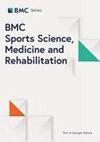摄氧效率高原不受体能水平的影响--NOODLE 研究
IF 2.1
3区 医学
Q1 REHABILITATION
引用次数: 0
摘要
耐力运动员(EA)是心血管健康的新兴关注人群。摄氧量效率高原(OUEP)是指摄氧量(VO2)和通气量(VE)之间比率的平缓期。在 EA 群体中,我们对 OUEP 预测模型进行了外部验证,并通过内部验证得出了一个新方程。140 名 EA 接受了医疗评估和最大自行车心肺运动测试。其中男性占 55%(N = 77,年龄 = 21.4 ± 4.8 岁,BMI = 22.6 ± 1.7 kg-m-2,峰值 VO2 = 4.40 ± 0.64 L-min-1),女性占 45%(N = 63,年龄 = 23.4 ± 4.3 岁,BMI = 22.1 ± 1.6 kg-m-2,峰值 VO2 = 3.21 ± 0.48 L-min-1)。OUEP 被定义为 VO2 和 VE 之间比率的最高 90 秒连续值。我们使用多变量逐步线性回归法建立了新的 OUEP 预测方程。男性和女性的 OUEP 分别为 44.2 ± 4.2 mL-L- 1 和 41.0 ± 4.8 mL-L-1。在外部验证中,OUEP 与直接测量值相当,没有显著差异。男性的预测误差为 - 0.42 mL-L- 1(0.94%,p = 0.39),女性为 + 0.33 mL-L- 1(0.81%,p = 0.59)。新开发的预测方程为:61.37-0.12-身高(厘米)+5.08(男性)。所开发的模型优于之前的模型。然而,该方程最多只能解释 12.9% 的方差(R = 0.377,R2 = 0.129,RMSE = 4.39 mL-L-1)。OUEP 是一个稳定且可转移的心肺功能指数。OUEP 受体能水平和人口因素的影响很小。预测的 OUEP 在 EA 中具有良好的前景,但准确性有限。得出的新模型专为 EA 量身定制。OUEP 可用于对运动的心肺反应进行分层并指导训练。本文章由计算机程序翻译,如有差异,请以英文原文为准。
Oxygen uptake efficiency plateau is unaffected by fitness level - the NOODLE study
Endurance athletes (EA) are an emerging population of focus for cardiovascular health. The oxygen uptake efficiency plateau (OUEP) is the levelling-off period of ratio between oxygen uptake (VO2) and ventilation (VE). In the cohort of EA, we externally validated prediction models for OUEP and derived with internal validation a new equation. 140 EA underwent a medical assessment and maximal cycling cardiopulmonary exercise test. Participants were 55% male (N = 77, age = 21.4 ± 4.8 years, BMI = 22.6 ± 1.7 kg·m− 2, peak VO2 = 4.40 ± 0.64 L·min− 1) and 45% female (N = 63, age = 23.4 ± 4.3 years, BMI = 22.1 ± 1.6 kg·m− 2, peak VO2 = 3.21 ± 0.48 L·min− 1). OUEP was defined as the highest 90-second continuous value of the ratio between VO2 and VE. We used the multivariable stepwise linear regression to develop a new prediction equation for OUEP. OUEP was 44.2 ± 4.2 mL·L− 1 and 41.0 ± 4.8 mL·L− 1 for males and females, respectively. In external validation, OUEP was comparable to directly measured and did not differ significantly. The prediction error for males was − 0.42 mL·L− 1 (0.94%, p = 0.39), and for females was + 0.33 mL·L− 1 (0.81%, p = 0.59). The developed new prediction equation was: 61.37–0.12·height (in cm) + 5.08 (for males). The developed model outperformed the previous. However, the equation explained up to 12.9% of the variance (R = 0.377, R2 = 0.129, RMSE = 4.39 mL·L− 1). OUEP is a stable and transferable cardiorespiratory index. OUEP is minimally affected by fitness level and demographic factors. The predicted OUEP provided promising but limited accuracy among EA. The derived new model is tailored for EA. OUEP could be used to stratify the cardiorespiratory response to exercise and guide training.
求助全文
通过发布文献求助,成功后即可免费获取论文全文。
去求助
来源期刊

BMC Sports Science Medicine and Rehabilitation
Medicine-Orthopedics and Sports Medicine
CiteScore
3.00
自引率
5.30%
发文量
196
审稿时长
26 weeks
期刊介绍:
BMC Sports Science, Medicine and Rehabilitation is an open access, peer reviewed journal that considers articles on all aspects of sports medicine and the exercise sciences, including rehabilitation, traumatology, cardiology, physiology, and nutrition.
 求助内容:
求助内容: 应助结果提醒方式:
应助结果提醒方式:


